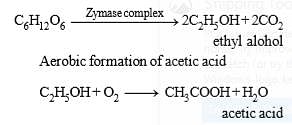Test: Microbes in Human Welfare - NEET MCQ
20 Questions MCQ Test Topic-wise MCQ Tests for NEET - Test: Microbes in Human Welfare
Directions: In the following questions, a statement of assertion is followed by a statement of reason. Mark the correct choice as:
Assertion: Besides curdling of milk, LAB also improve its nutritional quality by increasing vitamin-B12.
Reason: LAB, when present in human stomach, check disease causing microbes.
Directions: In the following questions, a statement of assertion is followed by a statement of reason. Mark the correct choice as:
Assertion: Streptococcus thermophilus increases nutritional value of milk.
Reason: Milk has lesser vitamin content than curd and yoghurt.
| 1 Crore+ students have signed up on EduRev. Have you? Download the App |
Directions: In the following questions, a statement of assertion is followed by a statement of reason. Mark the correct choice as:
Assertion : Vitamins B2 is found in cereals, green vegetables, brewer's yeast, egg white, milk and liver.
Reason : It can be commercially produced by some yeasts.
Directions: In the following questions, a statement of assertion is followed by a statement of reason. Mark the correct choice as:
Assertion : Lichen is important for chemical industries.
Reason : Litmus and Orcein are formed from lichens.
Directions: In the following questions, a statement of assertion is followed by a statement of reason. Mark the correct choice as:
Assertion : Yeasts such as Saccharomyces cerevisiae are used in baking industry.
Reason : Carbon dioxide produced during fermentation causes bread dough to rise by thermal expansion
Directions: In the following questions, a statement of assertion is followed by a statement of reason. Mark the correct choice as:
Assertion: Rennet and fruit extract of Withania somnifera have antagonistic functions.
Reason: Rennet is obtained from calf's liver and is used for curdling of milk.
Directions: In the following questions, a statement of assertion is followed by a statement of reason. Mark the correct choice as:
Assertion: After 24 hours, toddy becomes unpalatable.
Reason: The fermentation of toddy is continued by naturally occurring yeasts.
Directions: In the following questions, a statement of assertion is followed by a statement of reason. Mark the correct choice as:
Assertion: Beer and wine are called soft liquors while gin, rum, etc. are hard liquors.
Reason: Beer and wine are made without distillation.
Directions: In the following questions, a statement of assertion is followed by a statement of reason. Mark the correct choice as:
Assertion: Griseofulvin extracted from P. griseofulvum is used for ringworm treatment.
Reason: Trichophyton, Epidermophyton, etc. cannot grow well in presence of Penicillium griseofulvum.
Directions: In the following questions, a statement of assertion is followed by a statement of reason. Mark the correct choice as:
Assertion: Acetic acid production involves both aerobic and anaerobic processes.
Reason: Production of alcohol from glucose is an aerobic process and production of acetic acid from alcohol is an anaerobic process.
Directions: In the following questions, a statement of assertion is followed by a statement of reason. Mark the correct choice as:
Assertion: An organ transplant patient if not provided with cyclosporin A may reject the transplanted organ.
Reason: Cyclosporin A inhibits activation of T-cells and interferes with destruction of non-self cells.
Directions: In the following questions, a statement of assertion is followed by a statement of reason. Mark the correct choice as:
Assertion: The kneaded flour shows leavening, when yeast is added to it.
Reason: Enzymes secreted by yeast cause leavening.
Directions: In the following questions, a statement of assertion is followed by a statement of reason. Mark the correct choice as:
Assertion : Saccharomyces species are utilized for making alcoholic beverages.
Reason : Yeast has an enzyme, zymase responsible for fermentations.
Directions: In the following questions, a statement of assertion is followed by a statement of reason. Mark the correct choice as:
Assertion: Secondary treatment of sewage is also called biological treatment while primary treatment is called physical treatment.
Reason: Primary sewage treatment depends only upon sedimentation properties of materials present in sewage and filteration.
Directions: In the following questions, a statement of assertion is followed by a statement of reason. Mark the correct choice as:
Assertion: Energy value of biogas is lower than that of organic matter.
Reason: Biogas minimises the chances of spread of fecal pathogens.
Directions: In the following questions, a statement of assertion is followed by a statement of reason. Mark the correct choice as:
Assertion: Biogas is used as fuel for cooking and lighting.
Reason: It is considered as ecofriendly and pollution free source of energy.
Directions: In the following questions, a statement of assertion is followed by a statement of reason. Mark the correct choice as:
Assertion : Bioenergy is the energy available from biological sources.
Reason : Fossil fuels are examples of bioenergy.
Directions: In the following questions, a statement of assertion is followed by a statement of reason. Mark the correct choice as:
Assertion: Most orchid seedlings cannot develop well in the absence of fungal mycelium.
Reason: Fungal mycelium increases efficiency of absorption only.
Directions: In the following questions, a statement of assertion is followed by a statement of reason. Mark the correct choice as:
Assertion: Nucleic acid complexes alone cannot cause diseases.
Reason: Only nucleoproteins can function as infectious agents.
Directions: In the following questions, a statement of assertion is followed by a statement of reason. Mark the correct choice as:
Assertion: Dragonflies can be used to decrease occurrence of diseases like malaria, dengue, etc.
Reason: Baculoviruses are effective in controlling many insects and other arthropods.
|
9 docs|1272 tests
|


















